Let Your Exciting Adventures begin! The clothes you wear for a day hike are important for you to enjoy yourself, be safe and comfortable!
If you are just starting out with hiking, this is the time to give your attire a lot of thought up front so you can spend your money wisely. Be sure to think through the clothing & gear that you buy. In my opinion, you always want to think about functionality first- then fashion. Nothing wrong with wanting to wear brand names and look like a hiking babe on the trail, but you’re safety comes first.
With this said, there are times where the brand names are the way to go because they have the best quality and meet the requirements for ultimate comfort.
There is a balance of course- you have brands at REI for instance that are very expensive and some that are more reasonable. Ultimately, the best clothes you wear are related to the type of material, how well it’s made, and if you are comfortable wearing them.
The apparel options can be overwhelming. So- for this article, I wanted to keep it as simple as possible. I broke down the clothing system into the main layering categories- Base Layers, Insulation, and Protection. I discuss the features & materials for each and then provide specific recommendations.
{Affiliate Disclaimer: Some of the links in this guide go to my trusted affiliates. You pay nothing extra, and PeakFitnessOutdoors.com may make a small commission. Thank you so much for supporting this website and helping to inspire others to be healthy outdoors! I am an affiliate with Amazon. None of the product recommendations are sponsored}
Each layer has a distinct function- you can add or subtract layers to adapt to the changing conditions. It’s better to have more layers initially because you can always take them off and then stuff the extra in your backpack. Obviously if it’s hot outside you’re not going to layer like you would if it’s cold, wet and/or windy.
Base Layers
The base layers are also referred to as evaporation layers. As the next-to-skin layer, The purpose of the base layer is to move perspiration away from your skin (wicking). In cooler or cold conditions, long underwear that has wicking materials will help keep your skin dry.
The best base layers to wear include apparel made with natural fibers (Merino wool & silk) or synthetic based materials- like polyester & nylon.
These materials wick away or transport moisture away from the skin. This apparel is made in a way that allows moisture and heat to pass through the fabric.
Cotton is a natural fiber however that is never recommended for hiking. Cotton can steal your body heat on a cold day and possibly lead to hypothermia. Cotton also traps moisture on hot days preventing cooling which could lead to heat stroke.
- LAYERING POSITION: Worn next to skin
- MATERIALS: Natural fibers (Merino wool & silk), synthetics- like nylon & polyester. There are slight differences in durability, odor retention, wicking and drying for each material.
- PURPOSE: Worn in all conditions. Wicks sweat and moisture. Keeps you feeling dry and comfortable. Provides UPF Protection.
- BASE LAYER OPTIONS: Sports Bra, Underwear , T-shirt, Long Sleeve Shirt, Hiking pants-zip off bottom, Hiking shorts
Sports Bra
Since this is the very first layer that goes against your skin ,you need to make sure this layer is as comfortable as possible.
For women, it’s best to wear Sports Bras that keep the breast bouncing to a minimum, will prevent chafing, and will also wick away sweat.
A Few tips on finding a great sports bra:
- Avoid going cheap here- you don’t want a sports bra that offers little support and will wear out after a couple of months.
- Make sure the bra is made with moisture wicking fabric.
- Consider getting a hiking bra with adjustable straps which allows a custom fit for each breast.
- Avoid the cheap versions that give little to no support and wear out after a few months of soaking up sweat.
Underwear
For the bottom half, buy underwear that is also made of wicking material. If you hike in dry warm weather, your current nylon or cotton underwear will be fine when you’re starting out. But once you get involved into more extensive and longer hikes, you need to invest in under garments that are high performance.
Here are characteristics to look for:
- Breathable mesh fabric to keep you cool and dry
- Includes anti odor treatment
- Flatlock seams that reduce chafing, and easy to care for
- Has a spandex or Elastine in the material
In this case, you are better off with a well known brand. For instance, with under garments made by ExOfficio, they meet all these requirements. You literally need to buy only a couple pair at first. They are a bit more pricey, but will last a long time.
Short Sleeve Hiking T-Shirt
When choosing the best material and options for hiking t-shirts, look for key features.
Key features to consider:
- Moisture-Wicking and Quick-Drying: A must for keeping you dry and comfortable during long hikes. Look for fabrics that pull moisture away from your skin and dry quickly.
- Breathability: Important for regulating body temperature. Mesh panels and ventilation features can enhance breathability.
- UV Protection: Some hiking shirts come with UPF ratings to protect your skin from harmful UV rays. Look for a UPF 30+ rating.
- Odor Resistance: Merino wool naturally resists odors, and some synthetic shirts have anti-microbial treatments to help reduce odor buildup.
- Fit and Comfort: A good hiking shirt should have a comfortable fit that allows for a full range of motion. Flatlock seams can prevent chafing.
- Durability: Hiking can be tough on clothing, so look for reinforced stitching and abrasion-resistant fabrics.
Pro’s and con’s of the best materials and options to look for:
Merino Wool:
- Pros: You’ll love how soft the texture is. Excellent at regulating your temperature, moisture-wicking, odor-resistant
- Cons: Generally more expensive, may not be as durable than synthetics.
Synthetic Fabrics (Polyester, Nylon):
- Pros: Very durable, excellent moisture-wicking, dries quick, and is lightweight.
- Cons: Can retain odors, less breathable than natural fibers.
Blends (Merino Wool and Synthetic Mix):
- Pros: Has the benefits of both materials—odor control, durability, and moisture management.
- Cons: Price is more expensive
Bamboo:
- Pros: Soft, breathable, naturally anti-bacterial, eco-friendly.
- Cons: Less durable than synthetic options, slower to dry.
Short Sleeve T-Shirt Recommended Options
- Smartwool Merino 150 Base Layer Top: Lightweight merino wool, great for temperature regulation and odor resistance.
- Patagonia Capilene Cool Lightweight Shirt: Made from recycled polyester, excellent moisture-wicking, and quick-drying.
- Icebreaker Tech Lite Short Sleeve Crewe: Merino wool with a bit of nylon for added durability.
- Columbia Silver Ridge Lite Shirt: Polyester fabric with Omni-Wick moisture management and UPF 40 sun protection.
- Under Armour Tech Twist V-Neck: Lightweight polyester with UA’s signature moisture-wicking and anti-odor technology.
- REI Co-op Sahara T-Shirt: A budget-friendly option with good moisture-wicking and quick-drying properties.
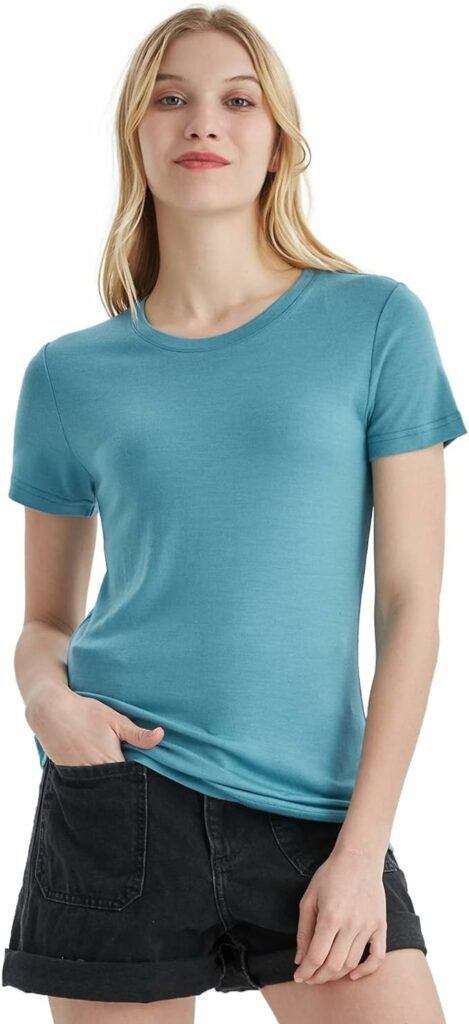
Hiking T-Shirt Summary
When selecting a hiking t-shirt, consider the conditions you’ll be hiking in and your personal comfort preferences. Merino wool is excellent for variable temperatures and multi-day hikes, while synthetic options are great for their durability and quick-drying properties. Blends offer a balance of both. Ensure the shirt you choose has the right features to keep you comfortable and protected on the trail.
Long Sleeve Hiking Shirt
When selecting the best material and options for long sleeve hiking shirts, the considerations are similar to those for short sleeve shirts but with added emphasis on sun protection and versatility in different weather conditions. Here’s a detailed look at the best materials and some top options:
Key Features to Consider
- Moisture-Wicking and Quick-Drying: Ensures you stay dry and comfortable. Essential for long hikes and variable weather conditions.
- Breathability: Look for shirts with good ventilation, often achieved through fabric technology or mesh panels.
- UV Protection: Many long sleeve hiking shirts offer UPF ratings to protect your skin from harmful UV rays. Aim for a UPF 30+ rating.
- Odor Resistance: Merino wool is naturally odor-resistant, and some synthetic shirts are treated with anti-microbial agents.
- Fit and Comfort: Should allow for a full range of motion with features like raglan sleeves and flatlock seams to prevent chafing.
- Durability: Hiking can be rough on clothing, so look for shirts with reinforced stitching and abrasion-resistant fabrics.
Best Materials
Merino Wool:
- Pros: Excellent at regulating temperature, moisture-wicking, odor-resistant, soft against the skin, provides some UV protection.
- Cons: Generally more expensive, can be less durable over time.
Synthetic Fabrics (Polyester, Nylon):
- Pros: Durable, excellent moisture-wicking, quick-drying, lightweight, often treated to provide UV protection.
- Cons: Can retain odors, sometimes less breathable.
Blends (Merino Wool and Synthetic Mix):
- Pros: Combines the benefits of both materials—odor control, durability, and moisture management.
- Cons: Can still be pricey.
Bamboo:
- Pros: Soft, breathable, naturally anti-bacterial, eco-friendly, often blended with other materials for improved performance.
- Cons: Less durable than purely synthetic options, slower to dry.
Long Sleeve Hiking Tops Recommended Options:
- Smartwool Merino 250 Base Layer Crew: Warm, comfortable, and perfect for colder hikes. Made from 100% merino wool.
- Patagonia Capilene Cool Daily Long Sleeve Shirt: Lightweight polyester, excellent moisture-wicking, quick-drying, and provides UPF 50+ sun protection.
- Icebreaker 200 Oasis Long Sleeve Crewe: Midweight merino wool, great for layering, offers natural odor resistance and breathability.
- Columbia Silver Ridge Lite Long Sleeve Shirt: Lightweight nylon with Omni-Wick moisture management and Omni-Shade UPF 40 sun protection.
- REI Co-op Sahara Long Sleeve Shirt: Made from polyester, this shirt is moisture-wicking, quick-drying, and offers UPF 50 sun protection. Features roll-up sleeves for versatility.
- Boody Long Sleeve Top: Made from bamboo viscose, it’s soft, breathable, and naturally odor-resistant.
- Mountain Hardwear Canyon Pro Long Sleeve Shirt: A durable option with good ventilation and sun protection. Made from a blend of nylon and polyester.
- Arc’teryx Motus AR Long Sleeve Zip Neck: High-performance polyester with good moisture management and breathability, plus a zip neck for ventilation.
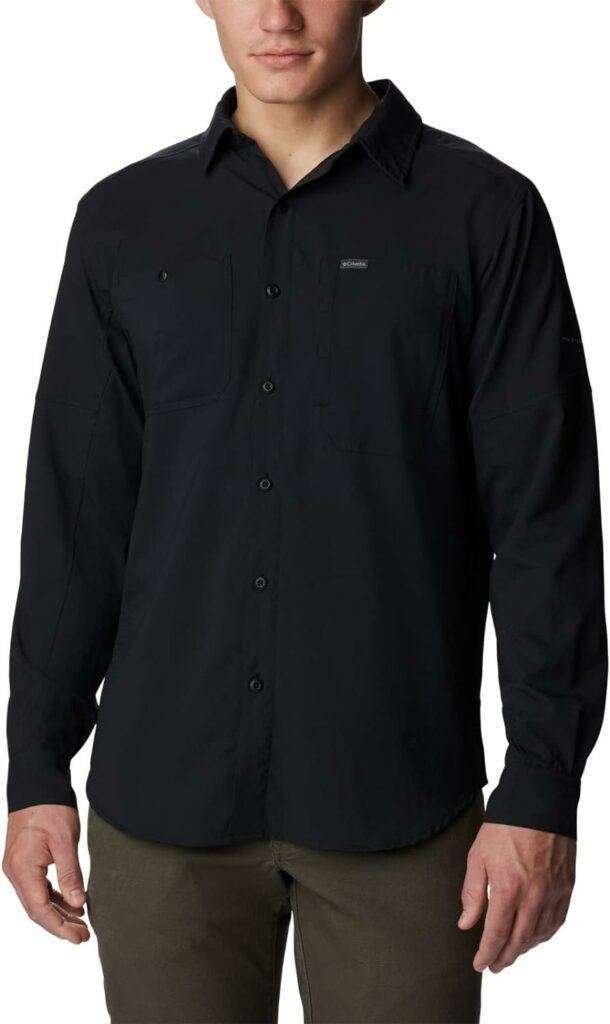
Hiking Pants
***Exceptions to this pants layer***
I am adding hiking pants as a base layer- but they could go in the insulating/middle layer as well depending on if you wear a layer under your hiking pants.
In really cold weather, I have worn silk long johns under my hiking pants. In most cases, your legs are not as sensitive to the cold as your chest area. And.. your vital organs are not in your legs. ? When you get moving.. your legs stay plenty warm just from the heat of your working muscle. (This is why in Most cases- you see runners wear shorts).
Overall, layering is less common terminology used with hiking pants and used more with your upper torso because keeping your core warm is more of a priority.
Okay, *whew*, with all the said.. when selecting hiking pants, it’s important to focus on features that provide comfort, durability, functionality, and suitability for various weather conditions.
Depending on the weather and trail you’re hiking, will determine if you wear hiking shorts or pants. Just below, I discuss the features/materials to look for and provide recommendations.
You want to have clothes that move with your body and won’t restrict you as you step over rocks, wade through rivers or while you’re taking a break. If it’s colder weather, you can wear polyester or silk long johns under your hiking pants.
If you prefer wearing shorts, make sure the trail you’re hiking isn’t overgrown. If the trail has a lot of vegetation that you have to walk through, it’s going to be uncomfortable with it rubbing against your legs the entire way. In some cases, you could be walking through poison ivy-yikes!
Do NOT Wear Jeans
Ideally, you want to stay away from wearing jeans. Yes- people do this. I just had a gentleman in my hiking MeetUp wear jeans. (This is a volunteer group so I don’t dictate what people wear). I do provide a checklist though of best practices, etc.
Okay, so anyway- he brushed by a cactus and got some pieces stuck in his jeans. He couldn’t get them out- he wasn’t able to roll up his jeans far enough. The jean material is thicker of course than other types of official hiking pants so the cactus was stuck in his pants. There are hiking pants that zip off at the knees- if he had those on he would have been able to get the cactus out.
Authentic denim is made of cotton. Not only are they heavier and bulkier than official hiking pants, they can become a hazard if they get wet. Cotton also absorbs sweat and takes more time to release the sweat leading to discomfort and chafing. In colder weather, this can lead to hypothermia.
Key Features to Look For in Hiking Pants
Materials:
- Synthetic Fabrics (Nylon, Polyester): These materials are durable, quick-drying, and often have good moisture-wicking properties.
- Spandex/Elastane Blends: These provide stretch for better mobility.
- DWR (Durable Water Repellent) Finish: Helps keep you dry in light rain.
Fit and Comfort:
- Articulated Knees: Pre-shaped knees for better mobility and comfort.
- Gusseted Crotch: Enhances range of motion and reduces seam stress.
- Adjustable Waist: Allows for a customized fit, often achieved with built-in belts or adjustable tabs.
Breathability and Ventilation:
- Breathable Fabrics: Helps manage sweat and keeps you comfortable.
- Ventilation Zippers: Often found on the thighs to enhance airflow during intense activity.
Weather Protection:
- Water-Resistant or Waterproof: Keeps you dry in wet conditions.
- Windproof: Protects against wind chill in exposed areas.
- Sun Protection (UPF Rating): Protects your skin from harmful UV rays; a UPF 30+ rating is ideal.
Versatility:
- Convertible or Roll-Up Pants: Can be converted into shorts or capris, offering flexibility in different weather conditions.
- Zippered Legs: Allow you to adjust ventilation and length.
Pockets and Storage:
- Multiple Pockets: Deep and secure pockets for storing essentials like maps, snacks, and tools.
- Zippered Pockets: Ensure items stay secure, especially when moving actively.
Durable:
- Reinforced Areas: Extra durability in high-wear areas like knees and seat.
- Abrasion-Resistant Fabric: Helps pants withstand rough terrain and frequent use.
Easy Movement:
- Stretchy Fabric: Incorporating spandex or elastane for better flexibility.
- Athletic Cut: Allows for better movement, avoiding overly baggy or restrictive designs.
Weight:
- Lightweight Fabric: Ideal for warm weather and high-activity levels.
- Insulated Options: Available for colder weather, providing warmth without excessive bulk.
Closure and Adjustment Features:
- Zipper Fly with Snap/Button Closure: Standard for secure fit.
- Integrated Belt or Belt Loops: For additional fit adjustment.
Hiking Pants Recommended Options
- Patagonia Quandary Pants: Made from lightweight nylon/spandex blend, DWR finish, UPF 50+ sun protection, and articulated knees.
- Prana Halle Pants: Stretch Zion fabric (nylon/spandex), water-resistant, articulated knees, and roll-up leg snaps.
- Columbia Saturday Trail Pants: Omni-Shield water and stain repellent, Omni-Shade UPF 50 sun protection, stretch fabric, and zippered pockets.
- Arc’teryx Gamma LT Pants: Fortius DW 2.0 fabric (nylon/elastane), durable, lightweight, and gusseted crotch.
- REI Co-op Sahara Convertible Pants: Nylon fabric, UPF 50+, zip-off legs for conversion to shorts, and multiple pockets.
- Outdoor Research Ferrosi Pants: Softshell fabric (nylon/spandex), highly breathable, lightweight, and wind-resistant.
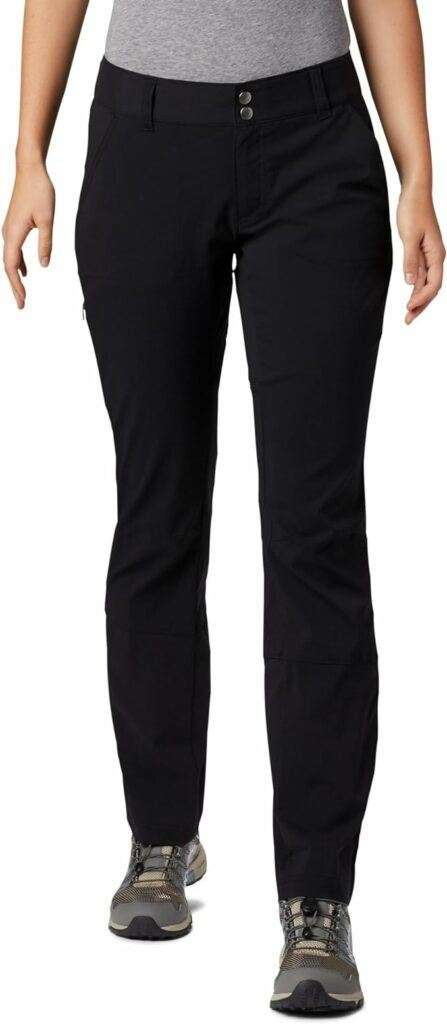
Hiking Pants Summary
Main ideas to keep in mind when selecting hiking pants- opt for materials that are durable, provide breathability, and stretch. Look for features like articulated knees, gusseted crotches, and adjustable waists for enhanced comfort and movement.
Ideally, the pants should provide appropriate weather protection, (water resistance, windproofing, or UV protection). Versatile designs like convertible pants can add functionality for varying conditions, and extra pockets enable you to carry other essentials.
Insulation/Middle Layers
- LAYERING POSITION: Worn over a base layer
- MATERIALS: Polyester fleece: Available in lightweight, midweight and heavyweight, Nylon, Wool
- PURPOSE: Added insulation for warmth. Retains heat produced by your body.
- MIDDLE LAYER OPTIONS: Nylon jacket, long sleeve lightweight wool top, soft shell sports jacket, a fleece jacket
As we discussed earlier, the main part of your body that needs layering is your upper body/torso. So the focus will be on tops for this layer vs bottoms. Just like the base layer, there are a variety of features and materials available for the middle layer.
Here are some common options for mid layers:
Polyester fleece: There are 3 different weights you can buy- lightweight, midweight and heavyweight fabrics (sometimes noted as 100, 200 and 300 weight). The nice feature about fleece is that it stays warm even if it gets damp and it dries quickly. Fleece also breathes well, so you’re less likely to overheat in it. If it’s windy though- the wind will go right through this material.
Down insulated jackets: These compress down for easy packing and has more warmth for its weight compared to any other material. Down is measured in fill power, goes from 450-900. Since the down is always inside a shell material, it provides a little bit of water and wind resistance. The downside is how it loses insulating efficiency when damp.
Synthetic insulated jackets: Synthetic jackets do not compress as well as down, but they are a popular option for rainy weather. These jackets keep their insulation when damp and the synthetic insulation provides additional water and wind resistance.
When selecting insulating tops for hiking, the key features to focus on ensure you stay warm, comfortable, and versatile across various weather conditions.
Key Features to Look For in Insulation Layers
Insulation Type
Down Insulation:
- Pros: Excellent warmth-to-weight ratio, compressible, highly packable.
- Cons: Loses insulating properties when wet unless treated with water-resistant down.
Look for: Fill power rating (higher numbers like 800+ indicate better quality).
Synthetic Insulation:
- Pros: Retains warmth when wet, usually less expensive, easier to care for.
- Cons: Heavier and less compressible than down.
Look for: Brands like PrimaLoft, Thinsulate, and Coreloft.
Material and Fabric:
Outer Shell
- Durable: Ripstop nylon or polyester for tear resistance.
- Water-Resistant: Durable Water Repellent (DWR) finish to shed light rain and snow.
Lining:
- Soft and Comfortable: Nylon or polyester lining that feels good against the skin.
Weight and Packability:
- Lightweight: Easier to carry and layer without adding bulk.
- Compressible: Can be packed down into a small stuff sack or pocket, ideal for space-saving in your pack.
Fit and Comfort:
- Athletic Fit: Provides a good range of motion without being too loose or too tight.
- Stretch Panels: Often under the arms or along the sides for better mobility.
- Articulated Sleeves: Allow for natural movement of the arms.
Warmth and Breathability:
- Temperature Rating: Ensure the top is suitable for the expected conditions.
- Breathable Fabrics: Help regulate temperature and prevent overheating during high activity levels.
Layering Compatibility:
- Slim Profile: Can be layered under a shell or over a base layer without bulk.
- Longer Hem: Provides better crack coverage and prevents drafts.
Features for Versatility:
- Hood: Adjustable: Fits snugly over a helmet or hat.
- Insulated: Adds extra warmth when needed.
- Pockets: Hand Warmer Pockets: Often lined with fleece for added comfort.
- Chest Pockets: For easy access to small essentials.
- Zippers: Full-Zip: Provides ventilation options and ease of layering. /Half-Zip: Reduces weight and bulk, useful for pullover styles.
- Adjustable Cuffs and Hem: Seal out the cold and provide a customized fit.
Durability:
- Reinforced Areas: High-wear areas like shoulders and elbows to resist abrasion.
- High-Quality Zippers and Stitching: Ensure longevity and reliable performance.
Recommended Options
- Patagonia Nano Puff Jacket: Synthetic PrimaLoft insulation, lightweight, highly packable, DWR finish.
- Arc’teryx Atom LT Hoody: Coreloft synthetic insulation, breathable side panels, durable, and versatile.
- The North Face ThermoBall Eco Jacket: ThermoBall synthetic insulation, retains warmth when wet, made with recycled materials.
- Mountain Hardwear Ghost Whisperer/2 Hoody: High-fill power down, ultralight, compressible, with a DWR finish.
- Rab Microlight Alpine Jacket: Hydrophobic down, lightweight, and packable with a Pertex Quantum shell for durability.
- Columbia Powder Lite Jacket: Synthetic insulation, thermal-reflective lining for added warmth, water-resistant fabric.
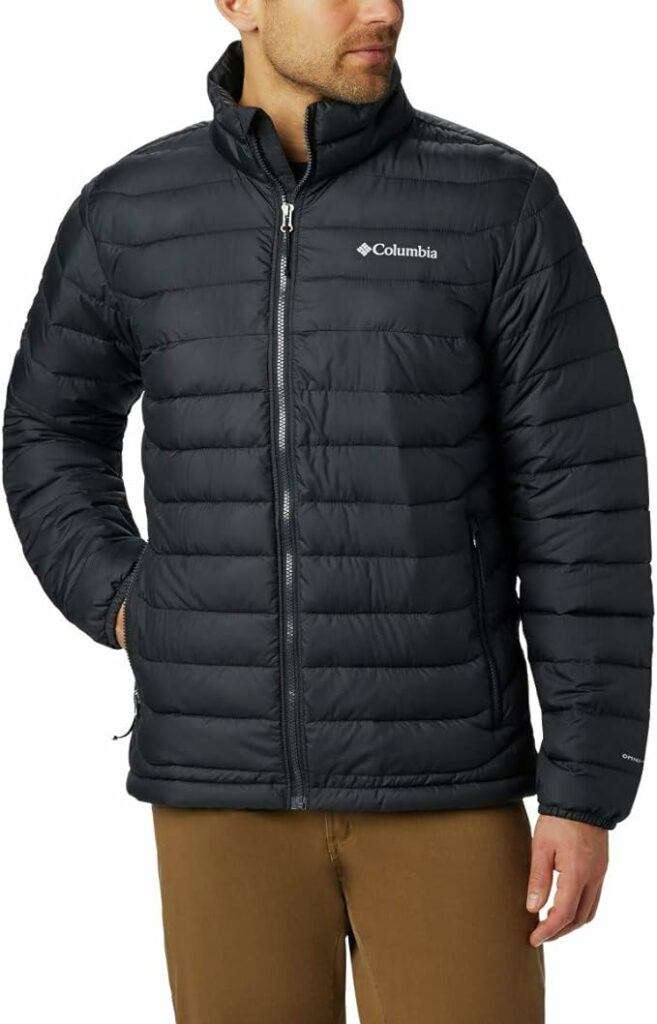
Mid Layer Summary
When choosing an insulating top for hiking, prioritize the type of insulation based on your needs for warmth, weight, and moisture management. Look for durable materials with a DWR finish, and ensure the top offers a good balance between warmth and breathability. Features like adjustable hoods, ample pockets, and reinforced areas add versatility and longevity to the garment. Fit and comfort are crucial, so opt for designs that allow for a full range of motion and layer well with other hiking clothing.
Protective Layer
The protective layer is just what it sounds like- Keeps you from being adversely affected by wind, rain, and snow.
When it comes to hiking, choosing the right protective layers or jackets is crucial for comfort and safety. There are three main types of jackets designed to address different weather conditions and hiking needs: hardshell jackets, softshell jackets, and insulated jackets.
Hardshell Jackets
- Purpose: Protection from rain, wind, and snow.
- Material: Made from waterproof and windproof materials, often featuring breathable membranes like Gore-Tex, eVent, or proprietary technologies from different brands.
Features:
- Fully waterproof and windproof.
- Durable Water Repellent (DWR) coating to help water bead off the surface.
- Sealed seams and waterproof zippers to prevent water penetration.
- Often lightweight and packable.
- Some models include ventilation features like pit zips.
Best For: Harsh weather conditions, heavy rain, and high winds.
Softshell Jackets
- Purpose: Balance of weather resistance and breathability.
- Material: Made from stretchable, breathable fabrics with a degree of water and wind resistance, often with a fleece or soft lining.
Features:
- Water-resistant but not fully waterproof.
- Highly breathable, allowing moisture and sweat to escape.
- Flexible and stretchy material for ease of movement.
- Often more comfortable for active wear due to better mobility and breathability.
- Some models have a DWR coating for light rain protection.
Best For: Mild to moderate weather conditions, high-output activities where breathability and flexibility are key, such as brisk hiking, climbing, or skiing.
Insulated Jackets
- Purpose: Provide warmth in cold conditions.
- Material: Can be filled with down (natural insulation) or synthetic fibers (e.g., PrimaLoft, Thinsulate).
Features:
- Excellent heat retention.
- Lightweight and compressible, especially down jackets.
- Synthetic insulation often retains warmth even when wet, unlike down.
- Outer material can vary, sometimes combined with a water-resistant shell.
- Some models feature removable liners or are part of a layering system.
Best For: Cold weather conditions, winter hiking, and situations where warmth is a priority. Layering under a hardshell for added protection against wet and windy conditions is common.
Recommended Options
When choosing protective layers for hiking, it’s important to consider the weather, terrain, and your activity level. Here are five highly recommended options for each layer type: hardshell jackets, softshell jackets, and insulated jackets.
Hardshell Jackets
Arc’teryx Beta AR Jacket
- Material: Gore-Tex Pro
- Features: Highly durable, waterproof, windproof, and breathable. Features include pit zips for ventilation and a helmet-compatible hood.
- Best For: Harsh weather conditions and demanding hikes.
Patagonia Torrentshell 3L Jacket
- Material: H2No® Performance Standard
- Features: Fully waterproof, breathable, and packable. It’s a more affordable option with adjustable hood and pit zips.
- Best For: Versatile use in wet weather conditions.
Softshell Jackets
The North Face Apex Bionic Jacket
- Material: WindWall® fabric
- Features: Water-resistant, windproof, and stretchy. Provides good breathability and mobility.
- Best For: Mild weather and high-output activities like hiking and climbing.
Black Diamond Dawn Patrol Hybrid Shell
- Material: Softshell with waterproof panels
- Features: Combines softshell flexibility with strategically placed waterproof protection. Breathable and offers good mobility.
- Best For: Active pursuits in variable weather conditions.
Insulated Jackets
Patagonia Down Sweater
- Material: 800-fill-power Advanced Global Traceable Down
- Features: Lightweight, highly compressible, and warm. Outer material has a DWR finish for light moisture protection.
- Best For: Cold weather hiking and as a mid-layer under a hardshell in harsher conditions.
Columbia OutDry Ex Reign Jacket
- Material: OutDry Extreme
- Features: Waterproof, breathable, and durable with an external membrane that doesn’t wear out.
- Best For: Reliable protection in persistent rain.
Marmot ROM Jacket
- Material: GORE-TEX INFINIUM™ with WINDSTOPPER®
- Features: Windproof, water-resistant, and breathable softshell. Stretch fabric for better movement.
- Best For: Windy conditions and active hiking.
Rab Microlight Alpine Down Jacket
- Material: 750-fill-power ethically sourced hydrophobic down
- Features: Warm, lightweight, and compressible with water-resistant outer fabric.
- Best For: Cold and damp conditions where lightweight warmth is needed.
Choosing the right combination of these layers will ensure you stay comfortable and protected in various hiking conditions.
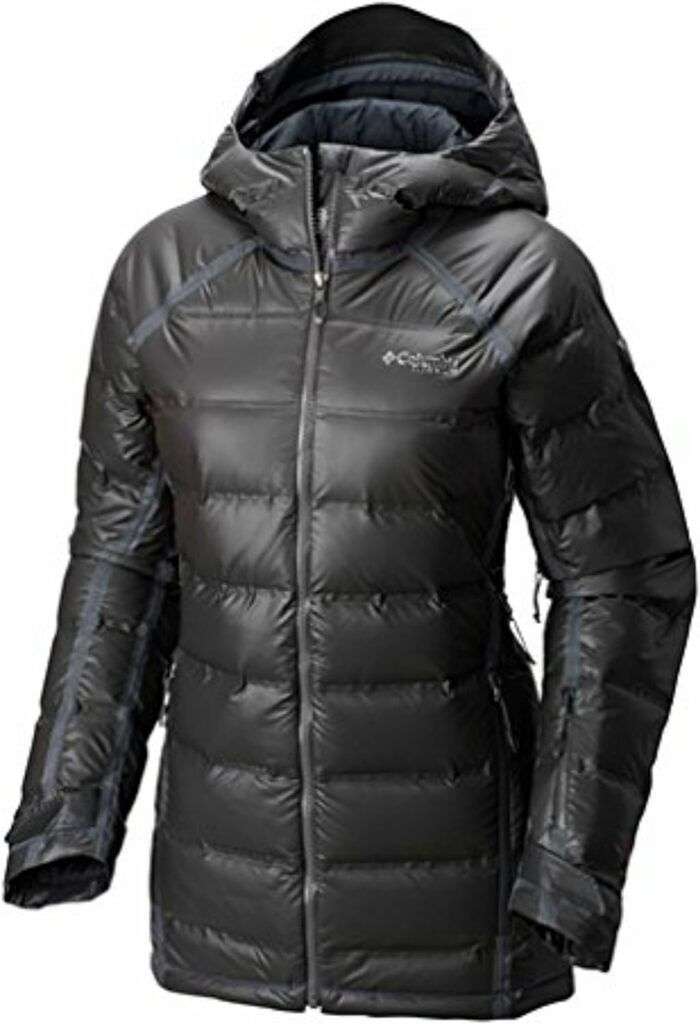
Additional Layers and Footwear
Aside from having the best tops and bottoms to keep you cool, dry and comfortable, you think about your other extremities as well. Head, hands, and feet are also important factors to consider. For your head and hands, putting on or taking off wool gloves or a hat is a quick way to adjust your comfort level. When you’re not using them, you can easily put them away in your pack.
For socks, there’s several options to choose from. Merino wool socks have moisture-wicking properties, temperature regulation (keeps feet warm in cold conditions and cool in warm conditions), naturally antimicrobial (reduces odor). The brand Darn Tough Hiker Micro Crew Cushion Socks are great quality and pretty reasonably priced.
Synthetic socks made from polyester, nylon, and/or spandex), are also excellent at moisture-wicking, quick-drying, durable, and often more affordable than wool. You can find synthetic socks designed with added cushioning and arch support. These are great for hiking in hot weather and if you’re more on a budget.
Liner socks: Thin, lightweight socks made from synthetic materials like polyester or silk. You can wear these under regular hiking socks to reduce friction and prevent blisters. These are best for long hikes and multi-day treks to help with moisture management and help to prevent blisters.
Finally, hiking boots or hiking shoes are the best choices to go with for optimum safety and comfort. If you are just starting your hiking journey, then reference these articles to help you make the right decisions:
What to Wear Summary
For optimal protection and comfort, the layering system is the way you want to go. Each layer has a purpose- you can add or remove layers to adapt to the changing conditions. Start with more layers initially because you can always take them off and then stuff the extra in your backpack.
The 3 main layers for your body include the base layer, insulating layer, and the protective layer. The base layer wicks moisture away from the skin, the middle layer provides insulation and keeps the heat in, and the protective layer will make you more comfortable and dry in the wind, snow, and rain.
As you’ve seen, there are many options to choose from. Some brand names stand out of course- but choose the apparel that works best for you regardless of the name.
What are your thoughts on the layering information I provided? Please leave your comments or questions!

